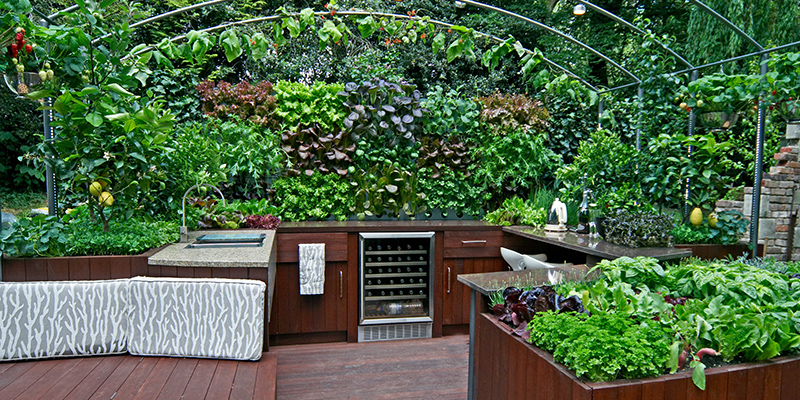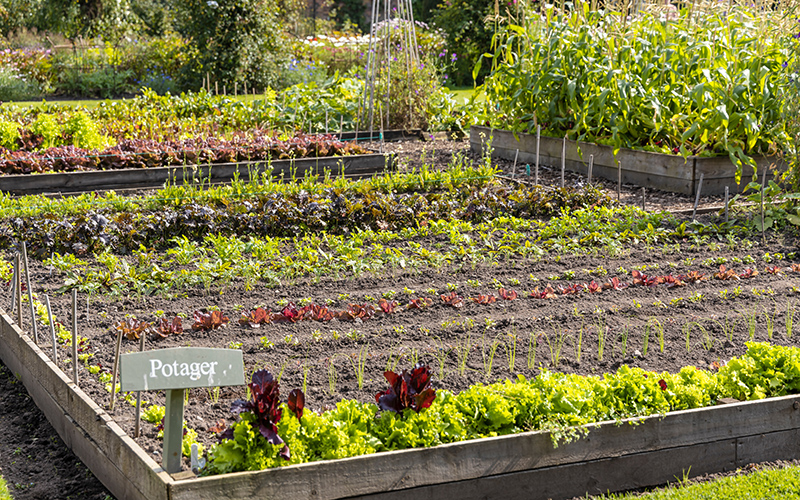So you want to start your own kitchen garden? Good for you! You’re on your way to eating fresh, homegrown produce. Read on to learn how to get started and other important information you need to know.
Traditional Backyard Vegetable Gardening vs Kitchen Gardening
Kitchen gardening differs from traditional backyard vegetable gardening as it focuses on smaller spaces, often taking advantage of vertical growing and concentrating on edible plants that can be incorporated into meals. Kitchen gardens can be as small as a single window box or as large as an entire yard but are usually much smaller than traditional vegetable gardens.
Unlike traditional vegetable gardens, kitchen gardens are often designed to grow many different types of edible plants in one space. This means that you can choose a variety of vegetables, herbs, and flowers that can be used together in meals.
For example, a kitchen garden might include tomatoes, lettuce, herbs, and squash. In contrast, a traditional backyard vegetable garden might only have tomatoes and lettuce.
Another difference between kitchen gardening and traditional backyard vegetable gardening is how the plants are grown. Traditional vegetable gardens are usually planted in rows and large open areas for harvesting. Kitchen gardens often use vertical growing methods, such as trellises and hanging baskets, to maximize available space.
Finally, kitchen gardens require less maintenance than traditional vegetable gardens. Since they are smaller and often planted in raised beds or containers, they require less weeding and watering and less time spent harvesting. This makes kitchen gardening an excellent option for those looking for an easy and low-maintenance way to grow their own food.
Benefits of Starting a Kitchen Garden

Starting a kitchen garden offers several benefits that can help improve your overall health, well-being, and lifestyle. Here are just some of the advantages of having your kitchen garden:
- Cost Savings – Growing your own food is a smart way to save money on groceries and lessen your environmental impact.
- Fresher & More Flavorful Produce – Homegrown produce is always fresher and more flavorful than store-bought produce.
- Health Benefits – Eating fresh vegetables and herbs from your garden can help improve your overall health and well-being.
- Exercise & Fresh Air – Gardening is a great way to get exercise and fresh air while providing a calming and rewarding activity.
- Stress Relief – Kitchen gardening can help reduce stress and anxiety by providing a calming and therapeutic activity.
- Bringing Nature Into Your Home – Kitchen gardens offer a great way to bring nature into your home and provide an enjoyable pastime.
What to Grow in a Kitchen Garden
When it comes to kitchen gardening, a variety of plants can be grown successfully. Here’s a list of top kitchen garden plants:
- Tomatoes are one of the most popular and easy-to-care-for plants to grow. They are easy to find and come in various shapes and sizes.
- Peppers are another popular choice for kitchen gardens. They can be grown in various colors and have a range of flavors, from sweet to spicy.
- Lettuce is a great choice, as it can be harvested quickly and easily. It is also a great source of vitamins and minerals.
- Kale is a hardy vegetable that can be grown in a kitchen garden and is packed with nutrients. It can be eaten raw, cooked, or added to salads and other dishes.
- Onions are a staple in many dishes and are easy to grow. They can be harvested quickly and can last for months when stored properly.
- Garlic is a fragrant and flavorful addition to any kitchen garden. It is easy to grow and can be harvested after a few months.
- Basil is a fragrant and flavorful herb perfect for a kitchen garden.
- Chives are versatile herbs that can be used in a variety of dishes.
Kitchen Garden Tools and Supplies

Once you’ve decided on the type of plants to grow in your kitchen garden, it’s time to stock up on the tools and supplies you’ll need for a successful crop. Here’s a list of what you should have on hand:
- Soil – Using a soil mix specifically designed for kitchen gardening is best.
- Containers – Containers such as plastic pots, wooden boxes, or even recycled items such as milk jugs or plastic bottles can be used.
- Seeds or seedlings – Beginners should start with seeds as they’re usually much cheaper than seedlings. You can purchase seedlings from your local garden center for those short on time.
- Fertilizer – Good quality fertilizer is essential for healthy plants, so be sure to get the right type for your specific plants.
- Watering can or hose – You’ll need something to water your plants with, such as a watering can or a garden hose.
- Pruning tools – Pruning shears or a pruning saw will be needed for trimming and shaping your plants.
- Stakes or trellises – If you’re growing vining plants, you’ll need something to support them, such as stakes or trellises.
- Gloves – Gardening gloves can help protect your hands from the dirt and grime of gardening.
- Pest control supplies – Insecticides, fungicides, and other pest control supplies may be necessary to protect your plants from pests.
Preparing Your Kitchen Garden
Once you have all the necessary supplies, it’s time to prepare your kitchen garden. Here are the steps to get started:
- Choose a spot for your garden that gets plenty of sunlight
- Prepare the soil by loosening it with a garden fork and adding compost or manure.
- Mix the soil with compost or manure. Add a mulch layer that can be spread to help retain moisture and suppress weed growth.
- If containers are used, fill them with soil and add seeds or seedlings.
- Follow the instructions on the seed packet or seedling label.
- Water the plants regularly and fertilize them when necessary.
- Harvest your produce and herbs when they’re ready.
Caring for Your Kitchen Garden

Once you’ve prepared the soil and planted your seeds or seedlings, it’s time to tend to your kitchen garden. Make sure to water your plants regularly, as most plants need at least an inch of water per week.
It’s also important to fertilize your plants regularly. Fertilizer helps to provide essential nutrients to your plants and allows them to grow. Select a fertilizer made specifically for kitchen gardens.
Finally, make sure to keep your kitchen herb garden weed-free. Weeds can compete with your plants for water and nutrients, so keeping them under control is essential. The most efficient weed control technique is to pull them by hand, but you can also use mulch or a weed barrier.
Common Kitchen Garden Pests and Diseases
Common pests can be a significant problem and can cause damage to plants if not appropriately managed. Fortunately, you can take some simple steps to keep your kitchen garden healthy and pest-free.
Common kitchen garden pests and diseases include:
- Aphids – These tiny insects feed on the sap of plants, causing leaves to wilt and become yellow. They can also spread viruses to plants.
- Caterpillars – These larvae feed on leaves, leaving behind ragged holes and causing defoliation.
- Slugs – Slugs feed on leaves, stems, and roots, leaving large, irregular holes in the plants.
- Whiteflies – These tiny insects feed on the underside of leaves, causing yellow spots and wilting.
- Powdery mildew – This fungus causes a white powdery covering on plant leaves, limiting growth and crop output.
- Blight – This fungus causes leaves to become brown, curled, and brittle. It can also cause stem and root rot in some plants.
- Root rot – This disease is caused by a fungus that attacks the roots of plants, causing them to become soft and discolored.
The best approach to prevent pests and diseases from taking over your kitchen garden is to keep it clean and healthy. Remove any dead or diseased plants, as these can attract pests and spread diseases to other plants. Make sure to keep your garden free of weeds, and use natural pest and disease control products when necessary.
Is Starting a Kitchen Garden Worth It?
With a kitchen garden, you can enjoy the benefits of growing your own ingredients for delicious homemade meals. This is a far healthier alternative to buying produce from the supermarket, plus it gives you more control over the flavors and textures of the food. In addition, gardening provides therapeutic benefits and is an excellent excuse to spend time outdoors.
You Can Also Read These:
- Organic Mulch vs Inorganic Mulch: What’s Best For Your Garden?
- Backyard Vegetable Garden For Beginners
- Practice Companion Planting For A Healthier And Thriving Garden




